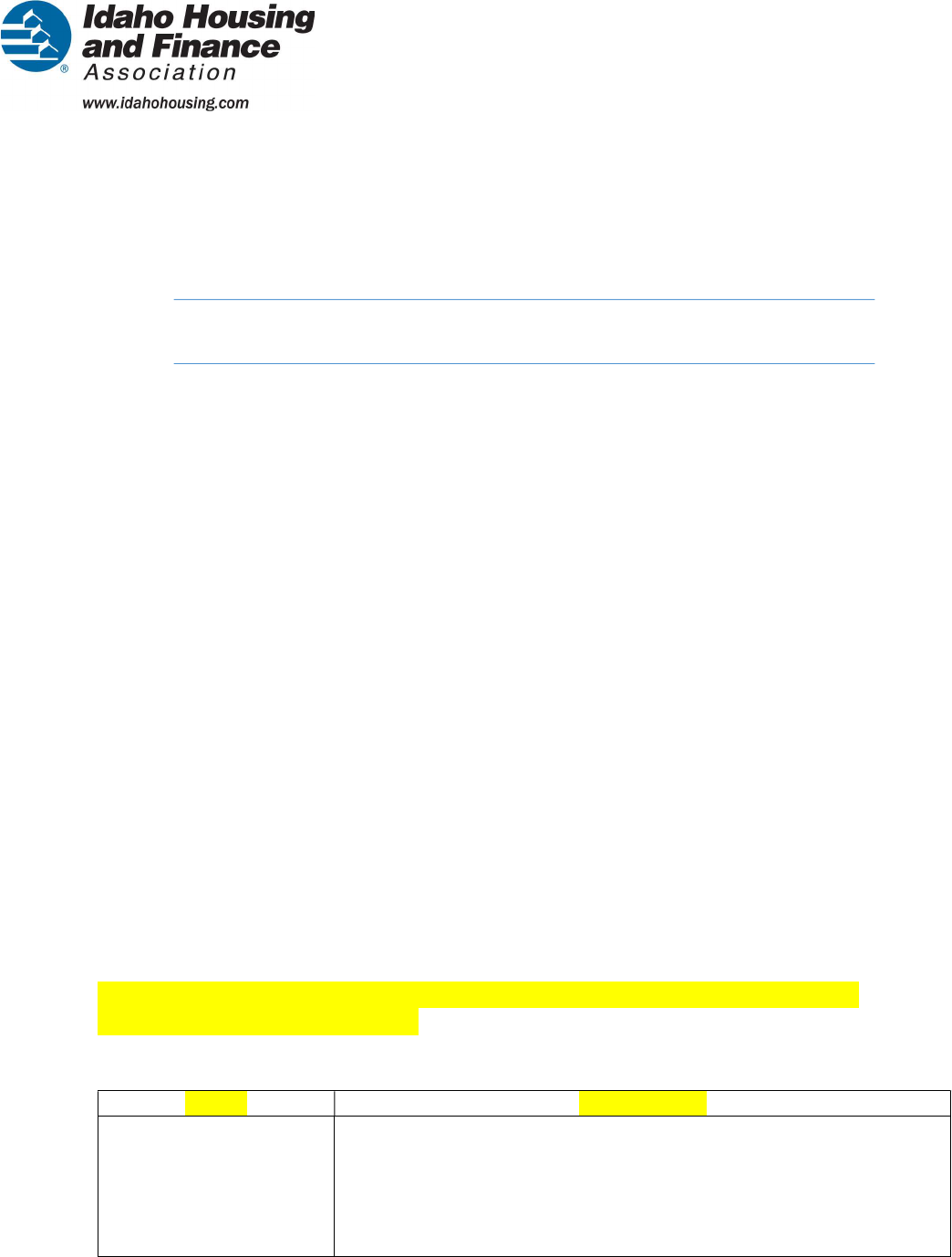
Homeowner Assistance Fund Plan
PROGRAM DESIGN
Program Template: Idaho Homeowner Assistance Program
Date: August 31, 2021 (updated 8/1/2023)
Term Sheet
Program Design Elements:
1. Allow homeowners to reinstate mortgages or pay other housing
related costs
2. Mortgage payment assistance (For three additional month post
reinstatement, if maximum assistance has not been reached)
3. Mortgage principal reduction, including with respect to a second
mortgage provided by a non-profit or government (To be used as a
last resort after all other loss mitigation options.)
4. Payment Assistance for homeowner’s utilities, including electric,
gas, home energy, and water
5. Payment Assistance for homeowner’s, flood, and mortgage
insurance
6. Payment assistance for homeowners’ association fees or liens,
condominium association fees, or common charges
7. Payment assistance for delinquent property taxes to prevent
homeowner tax foreclosures
NOTE- We are encompassing all seven of the above listed Design Elements into one
reinstatement/assistance program.
Criteria
Program Terms
Brief Description
This program will provide funds to eliminate or reduce past due
payments and other delinquent amounts, including payments under a
forbearance plan, on forward mortgages, reverse mortgages, loans
secured by manufactured homes, or contracts for deed.

HAF Funds may be used to bring the account fully current, with no
remaining delinquent amounts, and to repay amounts advanced by
the lender or servicer on the borrower’s behalf for property charges,
including property taxes, hazard insurance premiums, flood or wind
insurance premiums, ground rents, condominium fees, cooperative
maintenance fees, planned unit development fees, homeowners’
association fees or utilities that the servicer advanced to protect lien
position. Payment may also include any reasonably required servicer
fees, legal fees, and property preservation fees.
Provide payment assistance for up to three months in conjunction
with mortgage reinstatement unless maximum amount of assistance
has already been reached.
For mortgage reinstatement, funds may be used to help homeowners
resolve delinquent payments for utilities (power, sewer, trash, gas,
water) only if the outstanding past due amount is deemed to be a
barrier to the homeowner resuming regular monthly mortgage
payments. HAF funds may be used to pay prospective charges in full
including interest or reasonable required legal fees and under
circumstances in which a delinquency threatens access to utility
services. The provided assistance must bring the homeowner’s
account current.
For a homeowner that is concurrently going through loss mitigation
stemming from a coronavirus pandemic related delinquency, HAF
funds may be used for loss mitigation measures intended to result in a
permanently sustainable monthly payment for borrowers that are
unable to resume their monthly mortgage payment that is reset due
to investor offered loss mitigation. Funds may be used to effect
principal reductions; reduce the rate of interest; recast payment
terms; repay funds advanced by the servicer on the borrower’s
behalf; and as otherwise appropriate to ensure such assistance, when
leveraged with other available loss mitigation options and results in a
sustainable monthly payment amount for the borrower.
For homeowner’s without a mortgage or who have a reverse
mortgage, provide funds to resolve property charge defaults that
threatens a homeowner’s ability to sustain ownership of the property.
HAF funds may be used to pay past due property taxes, HOA fees,

condominium fees, or cooperative maintenance or common charges
that threaten sustained ownership of the property. Past due hazard
insurance may be covered for those with a reverse mortgage only.
Must be brought current by program assistance. For homeowner’s
without a mortgage or that have a reverse mortgage and are behind
on utilities, due to circumstances related to the COVID-19 pandemic,
funds may be used to help homeowners resolve delinquent payments
for utilities (power, sewer, trash, gas, water) only if the outstanding
past due amount is deemed to be a barrier to the homeowner
maintaining their home, being displaced, or creating an unsafe or
unsanitary environment. All other eligibility requirements must be
met.
IHFA will make reasonable efforts to have HAF participants identify
their loss mitigation options prior to, or in conjunction with providing
HAF assistance. HAF funds may be used to supplement other loss
mitigation options offered by the servicer under investor
requirements or where, without HAF funds, the homeowner would
not qualify for that loss mitigation option.
HAF Reinstatement
Program Goal
T
o mitigate financial hardships associated with the coronavirus
pandemic by providing eligible Idaho homeowners assistance for the
purposes of reinstating their delinquent mortgages, resume affordable
mortgage payments, and avoid foreclosure and displacement.
Size of HAF
Reinstatement Program
Idaho Housing and Finance Association will utilize up to $64,435,431 of
its total HAF allocation for this program. Remaining $7,500,000 is for
administrative costs.
Targeted Population of
Homeowners and
Financial Challenges
Program Seeks to
Address
IHFA will target Idahoans who are socially disadvantaged and those who
are low-to-moderate income.
Goal #1: Help low and moderate-income households return to housing
stability by assisting with past due mortgage amounts accrued while on
COVID-19 forbearance plans.
Goal #2: Stabilize the mortgage delinquency across Idaho.
Goal #3: Assist cost-burdened Idaho families attempting to exit
forbearance plans and get back on track.
Goal #4: Prevent disadvantaged and low-to-moderate income
households from displacement.
Homeowner Eligibility
“Eligible Homeowners” for Idaho’s HAF Reinsta
tement programs must
meet the following criteria:
• Homeowner must have experienced a Qualified Financial
Hardship after January 21, 2020(including a hardship that
began before January 21, 2020, but continued after that
date).
• Homeowner must currently own and occupy the property as

their primary residence.
• Homeowner must meet the Homeowner Income Eligibility
Requirements.
• Homeowner must be delinquent by at least one installment
payment or otherwise in default, as reflected in documentation
from the payee or the payee’s agent. Delinquency includes
missed payments during a forbearance period.
• Homeowners without a mortgage loan or who have a reverse
mortgage that are delinquent on state property taxes, HOA’s or
Condo Association dues, hazard Insurances(reverse mortgages
only), or utilities (power, sewer, trash, gas, water) and are at
risk of being displaced may be eligible for assistance if they
meet all other eligibility requirements. Delinquencies must
have occurred after January 21, 2020.
• Homeowner must attest that they experienced a financial
hardship after January 21, 2020. The attestation must
describe the nature of the financial hardship.
• Homeowners who have previously filed for bankruptcy but who
are no longer in bankruptcy must provide proof of court ordered
“discharge” or “dismissal”.
• Homeowner must complete and sign Affidavit, Application,
Disclosures, and 3
rd
Party Authorization forms
• Homeowner agrees to provide all necessary documentation to
satisfy program guidelines within timeframes established by
Idaho Housing and Finance Association, including self-
certification or attestation of socially disadvantaged status, as
applicable.
• The original, unpaid principal balance of the homeowner’s first
mortgage or housing loan, at the time of origination, was not
greater than the conforming loan limit in effect at time of
origination.
• Special consideration will be given to FHA, VA and USDA loans.
• Homeowner will provide a statement of current ability to
resume any required regular payments after account is
reinstated or brought current. Self attestation will be required.
Co-owners are not permitted to separately apply for HAF Program
assistance.
Eligible Legal Ownership
Structures
“Eligible Legal Ownership Structures” include only the following:
• Those where the home is owned by a “natural person” (i.e.,
LLP, LP or LLC do not qualify)
• Those where the homeowner has transferred their ownership
right into non- incorporated, Living Trusts, provided the
homeowner occupies the home as the primary/principal
residence.
Qualified Financial
Hardship
A “Qualified Financial Hardship”
is a material reduction in income or
material increase in living expenses associated with the coronavirus

pandemic that has created or increased a risk of mortgage delinquency,
mortgage default and foreclosure, loss of utilities or home energy
services, and displacement of a homeowner.
Reduction of Income – Documented temporary or
permanent loss of earned income [after January 21, 2020].
Increase in living expenses – Documented increase in out-
of-pocket household expenses such as, medical expenses,
inadequate medical insurance, increase in household size,
or costs to reconnect utility services directly related to the
coronavirus pandemic [after January 21, 2020].
Applicant attestation as to financial hardship after January 21,
2020*, including description of the nature of the financial hardship
(job loss, reduction in income, etc.)
*This includes documented hardship that began before January 21,
2020, but continued after that date.
Homeowner
Income Eligibility
Requirements
To be eligible for assistance under the Idaho HAF Reinstatement
Program, homeowners must have incomes equal to or less than 150%
of the area median income as published by HUD or 100% of the median
income for the United States, whichever is greater.
Income Determination: Applicant attestation as to household income,
plus supporting documentation, including paystubs, W-2s or other wage
statements, IRS Form 1099, tax filings, depository institution statements
demonstrating regular income, or an employer attestation.
Homeowner
Prioritization
Idaho Housing and Finance Association will prioritize funding to the
following populations:
Not less than 60% will be used for qualified expenses that
assist homeowners having incomes equal to or less than
100% of the area median income or equal to or less than
100% of the median income for the United States,
whichever is greater.
Amounts not made available to homeowners that meet the
above income-targeting requirement will be prioritized for
assistance to socially disadvantaged individuals as long as
they have incomes equal to or less than 150% of the area
median income or 100% of the median income for the
United States, whichever is greater.
o “Socially Disadvantaged Individuals” are those
whose ability to purchase or own a home has been
impaired due to diminished access to credit on
reasonable terms as compared to others in
comparable economic circumstances, based on
disparities in homeownership rates in the HAF
participants jurisdiction as documented by the U.S.
Census. The impairment must stem from
circumstances beyond their control. Indicators of
impairment under this definition may include being

(1) member of a group that has been subjected to
racial or ethnic prejudice or cultural bias within
American society, (2) resident of a majority-
minority Census tract; ( 3) individual with limited
English proficiency; (4) resident of an Indian
reservation, or (5) individual who lives in a
persistent-poverty county, meaning any county
that has had 20% or more of its population living in
poverty over the past 30 years as measured by the
three most recent decennial censuses.” (Treasury
Guidance Dated 8/2/2021)
All remaining funds not otherwise prioritized will be
available for other Eligible Homeowners.
Eligible Prope
rties
“Eligible Properties” are those that are:
• Single-family (attached or detached) properties
• Condominium units
• 1 to 4-unit properties where the homeowner is living in one of
the units as their primary residence. [EXCLUSION: If the
homeowner of a 1-4 unit property has received payments from
the Emergency Rental Assistance Program, they may be ineligible
to receive funds under the HAF Program.]
• Manufactured homes permanently affixed to real property and
taxed as real estate
• Manufactured homes permanently affixed to real property that
are on leasehold land, be subject to the mortgage lien, and be
insured by a title policy.
• Single-Family (attached or detached) properties that are on
leasehold land, be subject to a mortgage lien, and be insured by
a title policy.
Ineligible properties are those that:
• Vacant or abandoned
• Mobile homes not permanently affixed to real property
• 2
nd
homes
• Investment property
Eligible Uses of HAF
Reinstatement Program
Proceeds
“Eligible Uses of HAF Reinstatement Program Proceeds”:
Mortgages listed below must be held by a servicer with an NMLS
number. This would include federally backed and privately funded
mortgages. Mortgages not held by a servicer with a NMLS number will
be reviewed on a case-by-case basis.
Existing first mortgage lien loan payment (principal, interest,
taxes, insurance, and mortgage insurance, and HOA dues), to
include any escrow shortages.
Subordinate mortgage lien payment (P&I)
Manufactured home loan monthly payment (principal, interest,

taxes, insurance, and HOA dues) to include escrow shortages.
Land Contract monthly payment (P&I) (For lease held property
loans).
Homeowner’s association fees, condominium association fees or
common charges.
For a homeowner that is concurrently going through loss
mitigation stemming from a coronavirus pandemic related
delinquency, HAF funds may be used for loss mitigation
measures intended to result in a permanently sustainable
monthly payment for borrowers that are unable to resume their
monthly mortgage payment that is reset due to investor offered
loss mitigation. Funds may be used to effect principal
reductions; reduce the rate of interest; recast payment terms;
repay funds advanced by the servicer on the borrower’s behalf;
and as otherwise appropriate to ensure such assistance, when
leveraged with other available loss mitigation options and
results in a sustainable monthly payment amount for the
borrower.
Homeowner’s hazard, flood and/or mortgage insurance
Homeowner’s delinquent property taxes to prevent homeowner
tax foreclosure
Homeowner delinquent utility payments. Funds may be used to
help homeowners resolve delinquent payments for utilities
(power, sewer, trash, gas, water) only if the outstanding past
due amount is deemed to be a barrier to the homeowner
resuming regular monthly mortgage payments, or if the
outstanding past due amount is deemed to be a barrier to the
homeowner maintaining their home, being displaced, or creating
an unsafe or unsanitary environment.
Counseling or educational efforts by housing counseling agencies
approved by HUD or a tribal government or legal services,
targeted to households eligible to be served with funding from
the HAF related to foreclosure prevention or displacement
De Minimis lender-assessed fees
Maximum Per Household
HAF Assistance
Idaho Housing and Finance Association will not exceed its “Maximum Per
Household HAF Assistance” amount of $50,000 per household.
Form of Assistance
Assistance will be structured as an interest free loan, payable upon sale
and transfer of the property. For a transfer based on sale of the
property, the loan will be forgiven if the homeowner’s net proceeds
from the sale do not cover the HAF loan amount. The loan may be
forgivable after ten years.
Payout of HAF
Assistance/Payment
requirements
Idaho Housing and Finance Association will disburse HAF assistance
directly to mortgage lender/servicer or land contract holder, the Idaho
State Tax Commission, Hazard Insurance Provider, Homeowners’

Association/Condominium Association, or utility provider. Funds will not
be issued to borrowers or any other parties than those listed above.
Payments to lenders/servicers are only authorized to those
lenders/services that hold an NMLS number. Private party mortgages
will be reviewed on a case by case basis and there must be a recorded
deed of trust and proof and legal ownership
Funds will not be issued to borrowers or any other parties
Idaho Housing and Finance Association will make no more than one
disbursement to each payee, per application.
Idaho Housing and Finance Association will disburse the amount quoted
by the lender/servicer, land contract holder, State Tax Commission,
hazard insurance provider, HOA or condominium association or utility
provider. Any discrepancies to be resolved by the homeowner.
If homeowner’s past due amount exceeds the amount that Idaho
Housing and Finance Association can provide, homeowner may pay the
difference, and Idaho Housing and Finance Association will pay the max
of their limit.
HAF assistance will be prioritized to Eligible Uses of HAF Reinstatement
Program Proceeds as follows:
1) Mortgage/housing loan reinstatement (including escrows),
2) Property taxes and homeowner’s insurances (hazard and
mortgage)
3) Condominium/homeowners’ association fees
Disbursement to mortgage/housing lender/servicer may include up to
the next three scheduled monthly payment (“Additional Assistance”) if
funds are available not to exceed the Maximum Per Household HAF
Assistance.
Eligible homeowners will be allowed to apply more than once; provided
they have not exceeded the maximum household amount and that
program funds are still available. Applicants will be required to submit
a new application and provide proof of new COVID-19 hardship.
Program Launch
The application and intake process is designed
and will be operated in a
manner to avoid barriers to equitable access and allow flexibility,
particularly with regard to documentation requirements.
Homeowners will apply for assistance either through the online portal or
over the telephone.
Program Dur
ation
The period of performance for the HAF award begins on the date
hereof and ends no later than September 30, 2026, or sooner as
defined by US Treasury. HAF recipients shall not incur any
obligations to be paid with the funding from this award after such
period of performance ends.

Idaho Housing and Finance Association plans to disburse all funds
by the end of the Financial Agreement term, September 30, 2026,
or sooner as defined by the US Treasury.
Application Process
Idaho applicants will be able to
apply through an online portal and
by telephone with IHFA staff.
Required Application
Documents
Idaho Homeowner Reinstatement Program Application
Third Party Authorization (TPA) and Disclosure Form
Signed acknowledgement that Idaho HAF assistance is in the
form of a Loan due upon transfer by sale of the property.
Qualifying hardship attestation and supporting documentation
from homeowner certifying and identifying the eligible hardship
and that it occurred after January 21, 2020, as required
Mortgage Statement for each lien (e.g., first mortgage, second
mortgage).
Social Security Number or unique identifier as shown on a legal
document, such as federal tax return
Income documentation; W2’s, paystubs, previous years’ tax
returns or alternative income documents as applicable.
Homeowners’ association, condominium association or common
charges statements showing delinquent amount.
Homeowner’s hazard, flood and/or mortgage insurance
statement showing past due amounts
Homeowner’s delinquent property tax bill if not escrowed
Statement of current ability to resume regular monthly
payments after reinstatement and self attestation
Past due utility bills, if applicable
Photo Identification
Applicant must provide each payee’s contact and account information if
not listed on monthly statement.
Eligibility Determination
Notes
IHFA staff summarizes their determination of the applicant’s eligibility
and status in case notes; summary to include applicable details to
support the decision and advance the case through the pipeline and/or
action taken.
Quality Control (QC)
Idaho Housing and Finance Association will ensure program integrity by
undertaking system- generated, random selection of case reviews after
eligibility determination and prior to funding; 100% review of all declined
cases and a reasonable selection of each staff’s pipeline based on tenure
and performance, starting with 10% of volume decreasing to a minimum
of three cases weekly.
HAF Assistance
Approval
and Funds Disbursement
Reservations for assistance may not exceed the Maximum Per
Household HAF Assistance amount of $50,000; program staff will
summarize funding details based on applicant’s request and generally
prioritized as follows:
1) mortgage/housing payment reinstatement
2) property taxes and homeowner’s insurances

3) condominium /homeowners’ association fees
Funds will be paid, as applicable, to the mortgage servicer or other
third-party payee authorized by the servicer, or other third party
authorized to collect eligible charges in accordance with reinstatement
instructions received from the payee. Payments may be made through
electronic transmission for any payees that accept funds in this manner.
For other payees, funds will be sent directly by check or other payment
method accepted by the mortgage servicer or authorized payee.
Program Partner
Requirements
Lender/servicers to execute a HAF Partner agreement and agree
to communicate using the Common Data File (CDF) format that
will be used by other HFA’s administering the HAF program.
Private lenders, including Land Contract payees to provide
written delinquency quote, contact information, and ACH
account information.
All servicers/payees will need to provide a current signed W9.
Program Leverage with
Other Financial Resources
Idaho Housing and Finance Association will undertake best effort
approach to leverage the assistance that might be available for
homeowners through other federal programs that have been created
expressly for that purpose before using HAF funds.
Program Exclusions
Private mortgages not held by a lender/servicer with an NMLS
number, as determined on a case by case basis.
Mortgages that are current at the time of application.
Homeowners without a mortgage or that have a reverse
mortgage that have Taxes, HOA’s, utilities, or Insurances due
prior to January 21, 2020. (We will allow arrearages per Treasury
Guidelines)
Ineligible properties:
Vacant or abandoned
Mobile homes not permanently affixed to real property
2
nd
homes
Investment property
